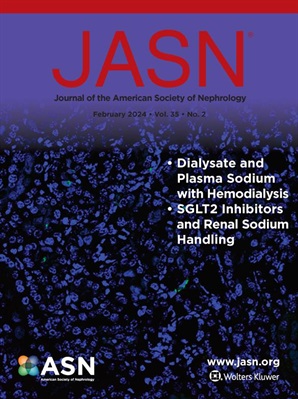减肥手术前后肾小球滤过率的测量、估计和相关因素。
IF 10.3
1区 医学
Q1 UROLOGY & NEPHROLOGY
引用次数: 0
摘要
减肥手术如何影响测量的肾小球滤过率(mGFR)和估计的肾小球滤过率(eGFR),以及哪些因素影响术后肾小球滤过率的变化,仍然是重要的问题。方法采用金标准方法,从所有7项可用的研究(日期:2004-2018)中收集数据,测量减肥手术前后的GFR。采用标准统计方法分析术后mGFR的变化、影响mGFR变化的因素以及对5个gfr估计方程的影响。结果该队列包括105名来自美国和欧洲的个体,68%为女性,97%为白人,平均年龄为50岁(范围:24-70),平均BMI为46±8 kg/m2。术前平均mGFR为107 ml/min(范围:31-215),术后降至92 ml/min (-14%, 95% CI: -21, -10),术前mGFR与GFR变化%之间存在很强的线性关系(r=-0.51;-0.64, -0.35)。术前mGFR≥90、60-<90和<60 ml/min的患者术后mGFR平均变化分别为-25(- 32,19)、1 (- 11,13 p =0.82)和7 (0,14)ml/min。体重变化与mGFR变化显著相关(r=0.22;0.03, 0.40)。在调整性别后,术后mGFR的变化与术前年龄较高相关(-0.6 ml/min /年;-1.1, -0.2), mGFR (-0.5 ml/min / 1ml /min;-0.6, -0.4)和收缩压变化(-0.3 ml/min / 1mmhg;-0.6, 0.0)。所有GFR估计方程都显著低估了保留肾功能的患者术后GFR降低,当去索引并应用于mGFR<90 ml/min的个体时,偏差、精度和准确性都有所改善。结论在接受减肥手术的肥胖患者中,术后mGFR下降幅度与术前GFR直接相关,与体重减轻仅呈弱相关。此外,gfr估计方程的性能在去索引并用于肾功能下降的人群时得到改善,其中肌酐/胱抑素C联合方程具有最佳的总体性能。本文章由计算机程序翻译,如有差异,请以英文原文为准。
Measurement, Estimation, and Correlates of the Glomerular Filtration Rate before and after Bariatric Surgery.
BACKGROUND
Important questions remain about how bariatric (i.e. weight loss) surgery affects measured glomerular filtration rate (mGFR) and estimated GFR (eGFR) as well as what factors influence change in mGFR post-surgery.
METHODS
Data were pooled from all seven available studies (dates: 2004-2018) measuring GFR pre- and post-bariatric surgery using gold standard methods. Change in post-surgery mGFR, factors that influence change in mGFR, and effects on five GFR-estimating equations were analyzed using standard statistical methods.
RESULTS
The cohort included 105 individuals from the US and Europe. 68% were female, 97% white, mean age was 50 years (range: 24-70), and mean BMI 46±8 kg/m2. Mean pre-surgery mGFR of 107 ml/min (range: 31-215) fell to 92 ml/min (-14%, 95% CI: -21, -10) post-surgery, with a strong linear relationship existing between pre-surgery mGFR and % change in GFR (r=-0.51; -0.64, -0.35). Individuals with pre-surgery mGFR ≥90, 60-<90, and <60 ml/min had -25 (-32, -19), 1 (-11, 13P=0.82), and 7 (0, 14) ml/min mean postoperative changes in mGFR. Change in weight was significantly correlated with change in mGFR (r=0.22; 0.03, 0.40). After adjusting for sex, changes in mGFR post-surgery were associated with higher pre-surgical age (-0.6 ml/min per year; -1.1, -0.2), mGFR (-0.5 ml/min per 1 ml/min; -0.6, -0.4) and change in systolic blood pressure (-0.3 ml/min per 1 mmHg; -0.6, 0.0). All GFR-estimating equations significantly underestimated post-surgical GFR reductions in people with preserved kidney function and had improved bias, precision and accuracy when de-indexed and applied to individuals with mGFR<90 ml/min.
CONCLUSIONS
In individuals with obesity undergoing bariatric surgery the magnitude of post-surgical decline in mGFR is directly associated with pre-surgery GFR and only weakly correlated with weight loss. Additionally, GFR-estimating equations' performance improved when de-indexed and used in people with reduced kidney function, with the combined creatinine/cystatin C equations having the best overall performance.
求助全文
通过发布文献求助,成功后即可免费获取论文全文。
去求助
来源期刊
CiteScore
22.40
自引率
2.90%
发文量
492
审稿时长
3-8 weeks
期刊介绍:
The Journal of the American Society of Nephrology (JASN) stands as the preeminent kidney journal globally, offering an exceptional synthesis of cutting-edge basic research, clinical epidemiology, meta-analysis, and relevant editorial content. Representing a comprehensive resource, JASN encompasses clinical research, editorials distilling key findings, perspectives, and timely reviews.
Editorials are skillfully crafted to elucidate the essential insights of the parent article, while JASN actively encourages the submission of Letters to the Editor discussing recently published articles. The reviews featured in JASN are consistently erudite and comprehensive, providing thorough coverage of respective fields. Since its inception in July 1990, JASN has been a monthly publication.
JASN publishes original research reports and editorial content across a spectrum of basic and clinical science relevant to the broad discipline of nephrology. Topics covered include renal cell biology, developmental biology of the kidney, genetics of kidney disease, cell and transport physiology, hemodynamics and vascular regulation, mechanisms of blood pressure regulation, renal immunology, kidney pathology, pathophysiology of kidney diseases, nephrolithiasis, clinical nephrology (including dialysis and transplantation), and hypertension. Furthermore, articles addressing healthcare policy and care delivery issues relevant to nephrology are warmly welcomed.

 求助内容:
求助内容: 应助结果提醒方式:
应助结果提醒方式:


